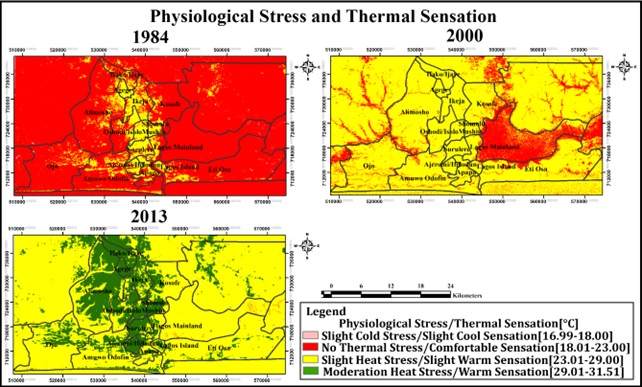A Study of Human Physiological Comfort in Lagos Metropolis Using Landsat Satellite Imagery Between 1984 and 2013

DOI:
https://doi.org/10.54060/jieee.2023.62Keywords:
Temperature Humidity Index, Physiological comfort, Physiological stress, Thermal sensation, Lagos metropolisAbstract
Our cities today are exposed more too urban atmospheric conditions that influence man’s comfort, health and behavior. As cities grow changes in land use have altered man’s physiological comfort experienced today. Landsat satellite imagery was used to study human physiological comfort in Lagos metropolis between 1984 and 2013. So, to achieve this remote sensing data acquired from Landsat satellite imagery and Geographic Information System (GIS) were used to derive, namely: land use land cover, land surface and air temperature, and relative humidity index for 1984, 2000 and 2013. While Temperature Humidity Index (THI) was computed from air tem-perature and relative humidity index which was used to assess human physiological out-door comfort in relation to land use activities. In this study, the health implica-tions of physiological stress and thermal sensation were highlighted and addressed from the environmental and health perspectives as it relates to land use. This study thrown open the door of environmental efficiency, well-being and the health of citi-zens which is influenced by physiological comfort through developing and maintain-ing comfortable environmental conditions that will enhance the quality of urban life.
Downloads
References
T. R. Oke, “The energetic basis of Urban Heat Island,” Quart. J. Roy. Meteorol. Soc., vol. 108, issu. 455, pp. 1-24, Jan. 1982.
U. S. Environmental Protection Agency, “Urban Heat Island basics,” Reducing Urban Heat Islands: Compendium of strategies, 2008. [Online]. Available: https://www.epa.gov/heat-islands/ heat-island-compendium [Accessed: Dec. 2, 2022].
P. Lenzuni, D. Freda, and M. Del Guadio, “Classification of Thermal environments for comfort assessment,” Ann. Occup. Hyg., vol. 53, issu. 4, pp. 325-332, Jun. 2009.
M. Prek, “Thermodynamical analysis of human Thermal comfort,” Energ., vol. 31, issu. 5, pp.732–743, Apr. 2006.
M. Boduch, and W. Fincher. (Sept. 2009). Standards of human comfort: Relative and absolute. Presented at UTSoA Seminar in Sustainable Architecture, Austin, Texas, USA. [Online]. Available:
https://repositories.lib.utexas.edu/handle/2152/13980
N. Kántor, and J. Unger, “Benefits and opportunities of adopting GIS in Thermal comfort studies in resting places: An urban park as an example,” Lands. Urban Plann., vol. 98, issu. 1, pp. 36-46, Oct. 2010.
G. Jendritzky, G. Havenith, Ph. Weihs, and E. Batchvarova, “COST Action 730 on the Universal Thermal Climate Index UTCI,” In 17th Int. Congr. Biometeorology, ICB 2005: Selected Papers from the Conf. ICB-2005, Garmisch-Partenkirchen, Germany, Sept. 5-9, 2005, pp. 309-312.
B. Tinz, and G. Jendritzky, “Europa-und Weltkarten der gefühlten Temperatur,” In Beiträge zur Klima-und Meer-esforschung, F.-M. Chmielewski, and Th. Foken, Eds., Berlin/Bayreuth, Germany, pp. 114-123, 2003.
J. O. Ayode, Techniques in Climatology. Ibadan, Oyo state, Nigeria: Stirling-Horden Publishers, 1993.
F. Oni, A. O. Adeaga, and U. Ibeabuchi, “A study of human Physiological Comfort in Lagos metropolis using satellite imagery between 1984 and 2013,” in Proc. Book of Abstract 9th UNILAG Annu. Res. Conf. and fair: Health, infrastructure, and development, Lagos, Nigeria, Oct. 8-10, 2014.
G. Jendritzky, H. Menz, H. Schirmer, and W. Schmidt-Kessen, “Methodology for the spatial evaluation of the Thermal component in the human Bioclimate: Updated Climate Michel model,” (in German), Beit. Akad. Raumforsch. Landespl., vol. 114 , p. 80, 1990.
A. Matzarakis, and H. Mayer, “Another kind of Environmental stress: Thermal stress,” December, 1996. [Online]. Available: https://www.urbanclimate.net/matzarakis/papers/who_heat.pdf [Accessed: Dec. 2, 2022].
A. L. Mabogunje, M. O. Filani, R. K. Udo, T. O. Okeye,…J. Woodford, “Town map,” In The National Atlas of the Federal Republic of Nigeria, O. Adebekun, D. A., Omoighi, O. A, Offiong, W. I. A., Okebadejo, G. E. K., Ofomata, J. O., Aina,...(Eds.), Lagos, Nigeria: Federal Ministry of Survey, 1978.
M. A. A. Abegunde, “Aspects of the physical environment of Lagos,” In History of the peoples of Lagos state, A. Ade-fuye, A. Babatunde, and J. Osuntokun, Eds., Ikeja, Lagos, Nigeria: Lantern Books, 1987, pp. 6-11.
J. A. Sobrino, N. Raissouni, and Z-L. Li, “A comparative study of land surface emissivity retrieval from NOAA data,” Rem. Sens. Environ., vol. 75, issu. 2, pp. 256– 266, Feb. 2001.
B. J. Choudhury, N. U. Ahmed, S. B. Idso, R. J. Reginato, and C. S. T. Daughtry, “Relations between evaporation coeffi-cients and vegetation indices studied by model simulation “, Rem. Sens. Environ., vol. 50, issu. 1, pp. 1–17, Oct. 1994.
J. I. Monteith, and M. H. Unsworth, Principles of environmental physics, 3rd ed. USA: Academic Press, pp. 395-401, 2000.
S. Nieuwolt, Tropical climatology: An introduction to the climates of the low latitudes. London, U.K.; New York, NY, USA; Sydney, Australia: J. Wiley & Sons, 1977.
A. G. Omonijo, and A. Matzarakis, “Climate and bioclimate analysis of Ondo state,” Meteorol. Zeitsch., vol. 20, no. 5, pp. 531-539, Oct. 2011.
A. Matzarakis, H. Mayer and M. G. Iziomon, “Application of Universal Thermal Index: Physiological Equivalent Tem-perature,” Int. J. Biometeorol., vol. 43, pp. 76–84, Oct. 1999.
P. R. Höppe, “Heat balance modeling,” Experien., vol. 49, pp. 741-746, Sep. 1993.
P. Höppe, “Die Energiebilanz des Menschen,” Ph.D. dissertation, Fakultät für Physik der Lud-wig-Maximilians-Universität München, München, Germany, 1984.
P. Höppe, “The Physiological Equivalent Temperature – A universal index for the Biometeorological assessment of the Thermal environment,” Int. J. Biometeorol., vol. 43, pp. 71-75, Oct. 1999.

Downloads
Published
How to Cite
CITATION COUNT
Issue
Section
Categories
License
Copyright (c) 2023 Uwadiegwu Ibeabuchi, Feyi Oni, Olusegun A. Adeaga

This work is licensed under a Creative Commons Attribution 4.0 International License.

























